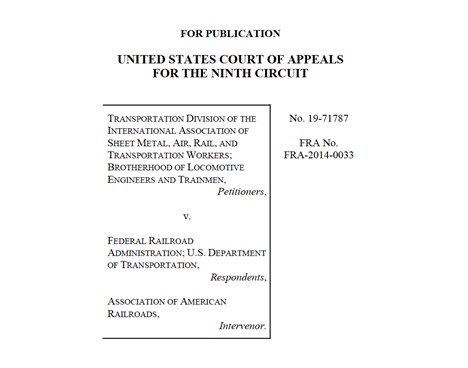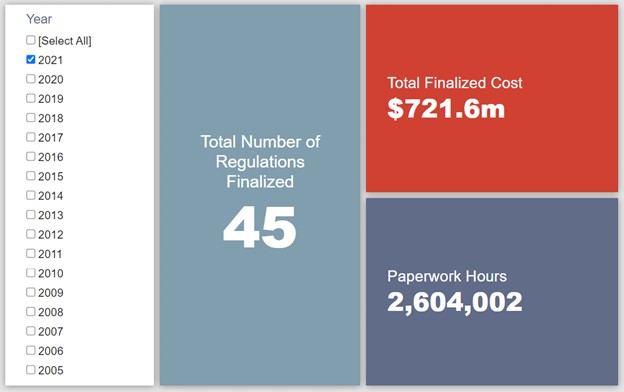Week in Regulation
March 1, 2021
Planes, Planes, and Really… Mostly Just Planes
This past week saw a notable uptick in the general volume of regulatory activity. Despite that, it was a fairly meager week in terms of actual economic impact. This was largely a product of the nature of the week’s rules. All but one of the rules that had some recordable economic impact were “airworthiness directives” from the Federal Aviation Administration (FAA). Across all rulemakings, agencies published $80.6 million in total net costs and added 690 hours of annual paperwork.
REGULATORY TOPLINES
- Proposed Rules: 87
- Final Rules: 116
- 2021 Total Pages: 11,830
- 2021 Final Rule Costs: $795.4 million
- 2021 Proposed Rule Costs: -$8.4 billion
NOTABLE REGULATORY ACTIONS
As mentioned above, last week’s haul of rules came predominantly in the form of FAA “airworthiness directives.” These rulemakings are relatively routine actions that direct aircraft manufacturers and operators to make certain modifications to their aircraft to address safety concerns. The economic impact of these actions is usually relatively modest (at least compared to some broader regulations). For instance, the most consequential of these actions from last week came with the estimated price-tag of $52.6 million, which provided the majority of last week’s cumulative cost total.
TRACKING THE ADMINISTRATIONS
As we have already seen from executive orders and memos, the Biden Administration will surely provide plenty of contrasts with the Trump Administration on the regulatory front. And while there is a general expectation that the new administration will seek to broadly restore Obama-esque regulatory actions, there will also be areas where it charts its own course. Since the American Action Forum’s RegRodeo data extend back to 2005, it is possible to provide weekly updates on how the top-level trends of President Biden’s regulatory record track with those of his two most recent predecessors. The following table provides the cumulative totals of final rules containing some quantified economic impact from each administration through this point in their respective terms.
![]()
The most notable trend from last week was the clear spike in rulemaking activity. For example, last Tuesday alone saw 50 final rule documents hit the Federal Register. Granted, many of these were not necessarily rules themselves, but rather items such as corrections to prior rules or extensions of effective dates. Nevertheless, there were still 12 new rules with enough of an impact to include for the tracking purposes here – that’s more than double the volume of the preceding Biden weeks combined. While there was a limited impact from these rules, it suggests that the new administration’s regulatory machinery is warming up slightly.
THIS WEEK’S REGULATORY PICTURE
This week, a federal court vacates a government order that sought to prevent a patchwork of state laws from inhibiting innovation in the railroad industry.

On February 23, the U.S. Court of Appeals for the Ninth Circuit ruled in a case challenging an order issued by the Federal Railroad Administration (FRA) in May 2019. The court vacated the FRA’s action and remanded it to the agency.
The order in question withdrew a 2016 proposed rule that would have required that train crews have at least two members on board. Citing that proposed rule’s chilling effect on innovation, including the development of automated trains, and its negligible impact on operational safety, the FRA concluded in the May 2019 order that crew size mandates were not necessary. The agency also went a step further, preempting states from setting their own crew size mandates.
The order was important because a patchwork of state laws with varying crew size requirements would wreak havoc on train operations, as trains would have to adjust crews as it traversed state borders. A crew size mandate also would have made it less likely that railroads would invest in promising automated train technologies that may increase safety and reliability. More information on the May 2019 order can be found here.
The court ruled that the FRA’s order did comply with the notice-and-comment requirements of the Administrative Procedure Act. The court specifically found that the 2016 proposed rule gave no indication that FRA might consider not establishing a minimum crew size, and as such the comment period associated with that proposal was insufficient to provide a public comment opportunity on the withdrawal order. The court also ruled that the order was arbitrary and capricious, and that it did not implicitly preempt states from setting their own mandates.
The ruling is a blow to enabling more research and investment in automation that could improve safety outcomes, and the reliability of rail networks. The issue now goes back to FRA and the Department of Transportation, with leadership now more aligned with that of the Obama Administration that proposed the 2016 rule. The ruling makes it likely that a crew size mandate will be imposed.
TOTAL BURDENS
Since January 1, the federal government has published $7.6 billion in total net cost savings (with $795.4 million from finalized rules) and 8.4 million hours of net annual paperwork burden reductions (with 2.6 million hours in increases from final rules).












